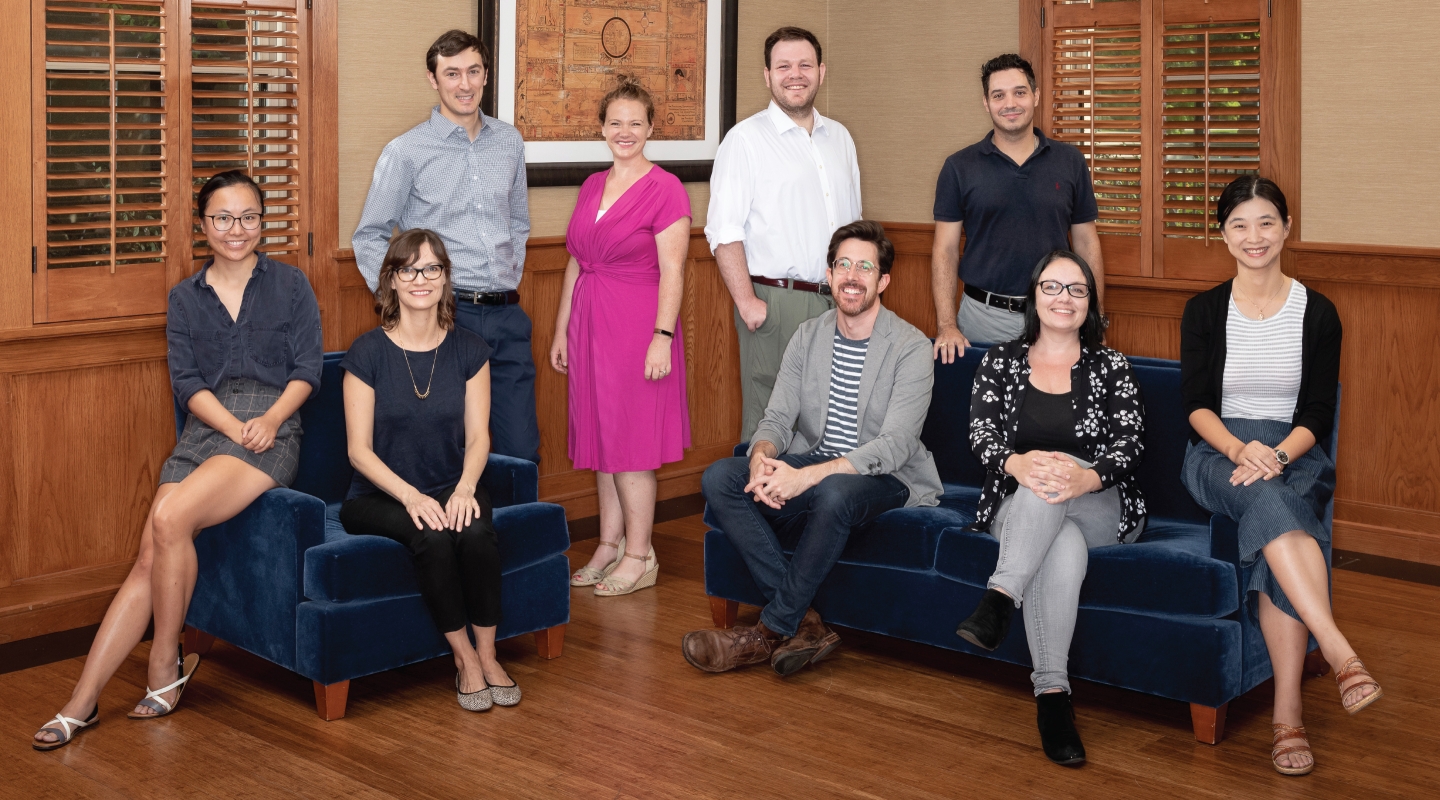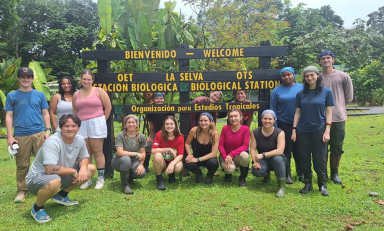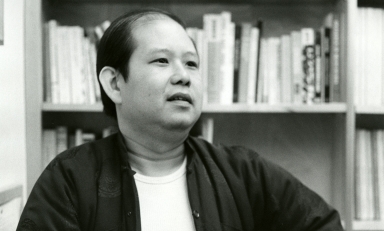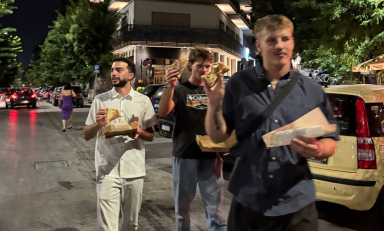Oxy’s new class of tenure-track faculty discuss the liberal arts, classroom life, papers, and podcasting
“Having lived in Los Angeles for 15 years, I developed a deep admiration for Oxy’s reputation, including its faculty and students,” says Madeline Baer, associate professor of diplomacy and world affairs. “Even so, when I came to campus to interview, I was completely blown away by the conversations I had with students. I knew that Occidental was home to some really exciting research, arts, and activism, but it was the students and their fierce commitment to engage with the world that made me so thrilled to join the Oxy community.”
Baer is one of nine new tenure-track faculty to join the College this fall—the largest number since 2014. We asked them all to tell us about themselves, their research, and their thoughts about a liberal arts education.
What attracted you to Occidental?
Sabrina Stierwalt, assistant professor of physics: Los Angeles is one of the best places in the world to do astrophysics research. There is a high density of top-tier institutions, observatories, and labs that form a leading astrophysics community. I was a staff scientist at Caltech but I found myself missing the creativity of teaching. Working with students who are learning how to approach problems in physics inspires me to think about things in new ways in my own research.
Celia Chen, assistant professor of computer science: At first, it was the short commute. However, looking back at my experience as an adjunct instructor, I greatly value the supportive and diverse environment that Occidental provides, which was the deciding factor.
Mariška Bolyanatz Brown, assistant professor of Spanish and French studies: So many things. The vibrant student population, the engaged faculty, the diversity of the L.A. backdrop—Oxy has it all!
What are your early impressions of classroom life?
Meimei Zhang, assistant professor of comparative studies in literature and culture/Chinese: I’m quite surprised about how respectful some of my students are. They say thank you to me every time when I finish a lecture. Although some of my students are extroverts and others are more shy, I do feel they value their opportunities to learn.
Timothy Rainone, assistant professor of mathematics: The students in STEM at Occidental are very talented; they are certainly capable of tackling tough concepts and handling a dense workload. I believe that it is up to us faculty to not let this talent go wasted. To that end I hope to engage and push my students miles from their comfort zone so that they may grow in maturity and in so doing meet far-reaching expectations.
Jorgen Harris, assistant professor of economics: I’ve had a great time in the classroom so far. I especially love the ways that my students are supportive and kind to each other and supportive and kind to me. I have been teaching a pretty fast and abstract chunk of the economics curriculum, and I was a bit worried that I would simultaneously stress and bore my students to death. My students have been up for the challenge, and ask great questions, work together, and demonstrate a ton of interest and curiosity.
Seva Rodnyansky, assistant professor of urban and environmental policy: So far, students are engaged and engaging, the discussions robust, and new topics are continually brought up and explored in class and beyond. I feel lucky to have hard-working students, who care about the world and making it better generally, and especially for underserved populations.
Michael Amoruso, assistant professor of religious studies: Oxy students keep me on my toes! So far, I’ve found them to be deeply engaged and careful thinkers who aren’t afraid to take risks.
What do you see as the value of a liberal arts education?
Amoruso: It prepares students to be intellectually nimble in an increasingly complex and changing world. It’s hard to say where innovations like automation and machine learning—not to mention the rapidly shifting geopolitical order—will take us in the next 20 or 30 years. In the face of such uncertainty, it’s more crucial than ever to cultivate the transferrable habits of mind characteristic of a liberal arts education.
Harris: The kind of thinking that a liberal arts education can teach can be really useful for learning as much as possible from your experience, for connecting your practical skills to as many domains as possible, and for guiding you through difficult decisions about how you want to spend your life. I’m not sure that a liberal arts education makes you a “better person,” but it can give you an ability to learn more, understand more, and be more thoughtful in your approach to life.
Baer: I think liberal arts education is at its best when it provides not only the foundations of knowledge and skills that students expect of a college education, but when it prepares students to take part in civic life as engaged political actors. Education should be transformational, and I think the liberal arts environment allows students and faculty to explore ways to take knowledge into the world in meaningful ways.
Madeline, your research explores the relationship between states, markets, and human rights through the lens of water policy in Latin America. What are the implications of defining access to water and sanitation services as human rights?
Baer: Defining water and sanitation services as human rights can be a very effective way to bring resources and attention to the stark inequities in access to water within and across countries. When the promise of equity and justice inherent in a human rights approach is combined with concrete policy, institutional and budgetary changes, access to water can be significantly improved in national contexts. However, rights alone are not enough—citizen participation in water governance, protection of the public character of water, and environmental stewardship are all necessary to make lasting improvements to water governance.
Jorgen, the title of your job market paper asks the question “Do Wages Fall When Women Enter an Occupation?” What were your conclusions?
Harris: I find that wages do fall when women enter an occupation—my estimates suggest that a 10 percentage point increase in the female share of an occupation’s workforce leads to a decrease in wages for men and women of about 7 to 8 percent. As to why, I have considered two broad hypotheses. First, the presence of women in an occupation might lower the prestige of an occupation in a manner that results in lower demand and lower wages. In this case, the negative effect of a female workforce on wages may represent a form of discrimination against women.
Alternatively, the presence of women in an occupation might lead employers to adopt costly practices that are valued more highly on average by female employees than by male employees, such as flexible scheduling. In this case, the negative effect of a female workforce on wages may represent useful accommodations to the preferences of workers.
Mariška, your dissertation examines the phenomenon of plural -s deletion in Chilean Spanish. Can you explain the socioeconomic implications of these acoustic cues?
Bolyanatz Brown: My analysis of novel acoustic measures on the vowel preceding the deleted plural -s revealed nascent changes in progress. Specifically, young speakers use distinct acoustic cues to differentiate singular and plural words according to their respective socioeconomic groups, while older speakers have completely neutralized this contrast. I argue that these vocalic strategies are a dialect-internal innovation, motivated by phonetic, morpho-phonological, and social factors, and which have the potential to contribute to longer-term sound change. The broader (socioeconomic) implications of phonetic variation can be observed in a scenario like a job interview: if someone hears a speaker using an undesirable feature or set of features, they may be (consciously or otherwise) less likely to think of that person as competent for the job at hand, though the candidate may be fully qualified.
Celia, can you talk about your research into software understandability?
Chen: Software understandability plays a pivotal role in software maintenance and evolution. A deeper understanding of code is the stepping stone for most software related activities, such as bug fixing. Being able to measure the understandability of a piece of code might help in estimating the effort required for a maintenance activity, in comparing the quality of alternative implementations, or even in predicting bugs.
Unfortunately, existing research points out that there is no correlation between understandability and code readability, and metrics generally used for effort estimation and commonly associated with understandability, such as Cyclomatic Complexity, actually have low or no correlation with understandability. Therefore, new ways to capture facets of code understandability is essential. What I have been doing is to utilize natural language processing techniques to analyze comments, commit messages and other non-source code software artifacts generated when producing source codes to examine whether these could be used to assess software understandability better.
Mariška, of the classes you have taught at Oxy, which is your favorite and why?
Bolyanatz Brown: I’d have to say two classes: Introduction to Linguistics (Ling 301) is a delightful way to introduce students to the world of thinking about language in a new way—or, perhaps, thinking about it consciously for the first time. Many of my former students have reported their excitement as they hear and can name a type of speech error on a podcast, or notice the close connection between variation in speech production and discrimination in the United States. The second would have to be Spanish in the United States (Span 342). In this course, students conducted mini fieldwork projects in Spanish-speaking communities in L.A., and compiled original data currently being assembled for a publication. This course also drew close connections among current themes such as politics, racism, and education policy, as we explored the value-adding of maintaining Spanish as a heritage language.
Tim, when did you discover you had a mind for mathematics?
Rainone: Toward the end of high school and in my first years of college I was blessed to have professors who loved mathematics and, as a result, taught the subject carefully and precisely. They introduced me to the beauty of mathematics and to the art of writing rigorous proofs. I began to appreciate the apparent objectivity of math. I don’t think I had a “mind for mathematics” per se, but rather began to see the beauty therein. Like anything in this world, we end up loving what we pursue.
Sabrina, what’s your podcast about?
Stierwalt: I host a weekly science podcast called Everyday Einstein through Macmillan Publishers. Each episode is only about six minutes and breaks down the science behind current events and long-standing questions: How did water get on Earth? Do those ancestry DNA kits really work? Or what does the scientific evidence have to say about the latest health craze? I get around 50,000 downloads per episode and I’m always looking for ideas, so send me your burning science questions!
Seva, you have a number of manuscripts at various stages of review. Can you talk about a favorite research topic, and what you have learned from it?
Rodnyansky: My dissertation and some subsequent work is about moving: how often, where, and what type of people make residential moves. This seemingly trivial, yet understudied, portion of human lives has large ramifications for policy and planning. Moving is a dynamic process: who moves in and out dictates the level of service governments and private agencies need to provide, from free school lunches and public transit to affordable housing and translation services. Static processes are easier to conceptualize and count—but, without including moving, it is easy to provide inadequate type or level of policy response.
Seated, l-r: Celia Chen, Madeline Baer, Michael Amoruso, Sabrina Stierwalt, and Meimei Zhang. Standing: Seva Rodnyansky, Mariška Bolyanatz Brown, Jorgen Harris, and Timothy Rainone.




